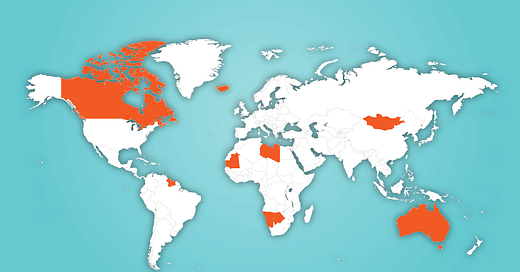The 10 most underpopulated countries in the world
Every continent represented! Except Antarctica... because it's not a country.
Sorry for the Buzzfeed style listicle. I’m a little crunched for time this week due to some upcoming travel and I don’t get PTO so… listicle! Regardless, I was legitimately curious at what some of the most underpopulated countries might be so I pulled the list anyways. Of course, population counts are mostly just estimates, especially for many of these counties, so take all of this with a little grain of salt.
And while “underpopulated” and “overpopulated” are loaded terms — many places claim they have too many people when, in fact, they do not — we can quantifiably measure this by way of the population density, one of my personal favorite forms of measuring population. Because who cares how many people your country or city has really? It gives you very little information. But population density can give you ideas of the look, feel, types of land use, types of transportation, types of goods, style of streets, and more! It’s not perfect, but far more helpful, in my opinion.
Top 10 underpopulated countries by population density
1. Mongolia (Asia)
Population Density: Approx. 2 people per square mile
Notable Geographic Features: Vast steppes, the Gobi Desert
Economic Focus: Mining, agriculture
Mongolia is often considered the most sparsely populated country globally, with its inhabitants scattered across a massive landscape dominated by rugged mountains and arid deserts. Mining, particularly coal and copper, drives much of the country's economy. The traditional nomadic lifestyle still persists, but urbanization is increasing, primarily centered in the capital city of Ulaanbaatar.
2. Namibia (Africa)
Population Density: Approx. 8 people per square mile
Notable Geographic Features: Namib Desert, Etosha Pan
Economic Focus: Mining, tourism
Namibia is characterized by stunning but harsh landscapes like the Namib Desert and the Etosha salt pan. Its low population density can be attributed to these challenging terrains. The country has rich mineral resources like diamonds, and tourism is a growing sector, focusing on its unique landscapes and wildlife.
3. Suriname (South America)
Population Density: Approx. 8 people per square mile
Notable Geographic Features: Amazon Rainforest
Economic Focus: Mining, agriculture
Suriname is largely covered by the Amazon rainforest, which limits population density. Mining, especially bauxite, and agriculture, including sugar and rice, are significant sectors in its economy.
4. Australia (Oceania)
Population Density: Approx. 9 people per square mile
Notable Geographic Features: Outback, Great Barrier Reef
Economic Focus: Mining, agriculture, tourism
Australia's vast interior, known as the "Outback," contributes to its low population density. Most Australians live along the coastline, where cities like Sydney and Melbourne are located. The country is rich in mineral resources like iron ore and gold, and it also has a robust agricultural sector.
5. Iceland (Europe)
Population Density: Approx. 9 people per square mile
Notable Geographic Features: Volcanoes, glaciers
Economic Focus: Fishing, tourism, renewable energy
Iceland's low population density is due, in part, to its challenging geography featuring volcanoes, glaciers, and rocky terrains. Fishing has traditionally been the backbone of its economy, but tourism and renewable energy (especially geothermal energy) are emerging sectors.
6. Libya (Africa)
Population Density: Approx. 9 people per square mile
Notable Geographic Features: Sahara Desert, Mediterranean coastline
Economic Focus: Oil production
Libya's population is concentrated along its Mediterranean coast, as the interior is dominated by the Sahara Desert. Oil production is the cornerstone of the Libyan economy, although political instability has impacted its output.
7. Mauritania (Africa)
Population Density: Approx. 10 people per square mile
Notable Geographic Features: Sahara Desert
Economic Focus: Mining, fishing
Mauritania is largely covered by the Sahara Desert, making it inhospitable for large-scale human settlement. The country has significant iron ore deposits and a burgeoning fishing industry along its Atlantic coast.
8. Botswana (Africa)
Population Density: Approx. 10 people per square mile
Notable Geographic Features: Kalahari Desert, Okavango Delta
Economic Focus: Diamond mining, tourism
The Kalahari Desert covers much of Botswana, contributing to its low population density. The country is one of the world's largest diamond producers, and tourism, especially wildlife tourism in places like the Okavango Delta, is a growing industry.
9. Guyana (South America)
Population Density: Approx. 10 people per square mile
Notable Geographic Features: Coastal plains, rainforest
Economic Focus: Agriculture, mining
Much of Guyana is covered by dense rainforest. The economy is primarily based on agriculture (sugar, rice) and mining (gold, bauxite).
10. Canada (North America)
Population Density: Approx. 10 people per square mile
Notable Geographic Features: Rocky Mountains, Arctic tundra
Economic Focus: Natural resources, technology
Canada's massive size and challenging geography, including its Arctic regions, make it one of the most sparsely populated countries. The nation is rich in natural resources like oil and timber, and it has a growing technology sector, particularly in cities like Toronto and Vancouver.
Unique challenges and opportunities
Countries with low population densities face distinctive challenges in land management, resource utilization, and economic development. The scarcity of human capital often impacts the provision of public services and infrastructure. Moreover, these countries may find it challenging to scale their economies due to a limited domestic market.
However, low population density also presents opportunities. These countries typically have abundant natural resources, from minerals to arable land, offering avenues for economic development. Further, their low density may make them more resilient to certain challenges like urban congestion and pollution.





If Greenland were an independent country, it would be the least densely populated of all, with less than 60,000 people spread out over an area greater than Mexico.